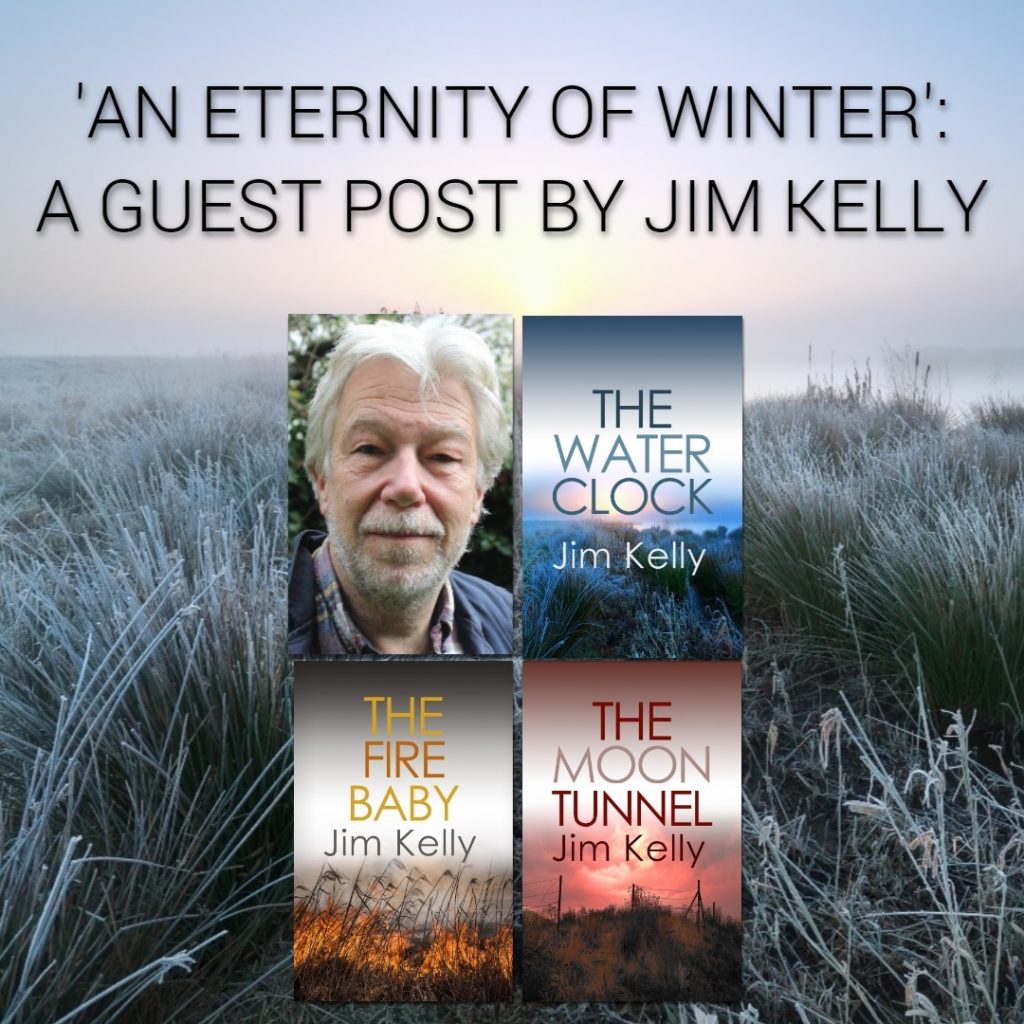‘An eternity of winter’ – a guest post by Jim Kelly
As we near the start of the Christmas holidays, we’re delighted to welcome author Jim Kelly to the blog for his seasonal, crime fiction reflections.

Sometimes a single line of fiction can change your life. For me it was this, on the third page of my (American first edition) of Dorothy L Sayers’ Fen masterpiece – The Nine Tailors. Our hero, Lord Peter Wimsey, is stranded in a snowstorm on Christmas Eve, trudging towards the sound of church bells with his faithful batman Bunter. Their car has slipped from the icy road into a deep ditch. Snowflakes swirl around them in the dark. They come across a signpost pointing down a track that reads Fenchurch St Peter. “There was no other direction: ahead, road and dyke marched side by side into an eternity of winter.”
I’ve re-read this opening chapter many times. Its pungent air of mystery, allied to an overwhelming sense of place, made a huge impression on my ten-year-old imagination. At that point in time I was growing up in a dull London suburb, with vague ambitions to be an architect. Approximately thirty years later I was living in Ely – in the shade of the great cathedral which is The Ship of the Fens – and writing the first of the Philip Dryden mysteries, set in that vast, flat world. My opening chapter of The Water Clock sees our hero, journalist Philip Dryden being driven – by his faithful sidekick Humph – to the river, where a car has been discovered trapped below the ice. The boot holds a grisly surprise.
To complete the circle back to that opening page of Sayers’ novel, I was at that time faithfully learning how to ring church bells on a Friday night, so that eventually I could take my ‘place’ in the belfry each Sunday. Often, on wintry practice nights, we’d all sit and wait for ringers we knew would be struggling to get to Ely – on its famous isle – across the flooded Fens. I often thought these conversations could have been transposed directly from Sayers’ book. Given the grisly denouement of The Nine Tailors, I always had a healthy respect for the dangers of church bells.
Of course, winter is a Godsend for crime writers. A nice crisp blanket of snow effectively turns every building, every home, into a classic ‘locked-room’ – footsteps betray all but the cleverest of villains. A seasonal blizzard can trap our cast of characters away for days. The key scene in The Water Clock sees the cathedral enveloped in a blizzard, the body of an unknown man found frozen beside the gargoyles of the great roof. I hope Sayers would have enjoyed the moment, as snow swirls around our amateur detective Philip Dryden, a journalist on The Crow, my Ely’s mythical newspaper.
And Ely’s island status means it’s a locked room all the time. Perched on its hill it looks out over the unforgiving Black Fens, hundreds of miles of peat, crisscrossed by rivers and ditches, and endless arrow-straight droves down which horses and cattle and geese were taken to market. It’s a maze, a puzzle, set out like an open map. Out in the distance small hamlets of lonely cottages only betray themselves at night, as a light twinkles, or smoke crosses the moon. In the 21st century it is surely unique to be able to travel an hour from London and find yourself lost in a landscape made for mystery. And you still can – or simpler still, read one of the Dryden mysteries, now re-issued by Allison & Busby.
The Water Clock, The Fire Baby and The Moon Tunnel, the first three Dryden Mysteries, are now available in ebook. You can also check out Jim’s Nighthawk series set in wartime Cambridge here, the latest instalment, The Night Raids, will be released in February.
One thought on “‘An eternity of winter’ – a guest post by Jim Kelly”
Leave a Reply
You must be logged in to post a comment.



Thank you, Jim. I really enjoyed reading your blog.
Dorothy Sayers and her husband were friends of my Grandparents. I’m not sure how they met, as my grandparents lived in Kirkcudbright, South West Scotland. That is were Dorothy wrote 5 Red Herrings.
A story my Mother told me was fun.
My family had a beach house known rather obviously as ‘ the Bungalow’ about 15 miles from Kirkcudbright. The Sayers were staying with my grandparents in Kirkcudbright at the time. An expedition to the Bungalow was mooted, Dorothy’s husband offered to give the children a lift. Three young teenage girls, 13, 15 and 16. They were the first to arrive. For some reason they didn’t feel comfortable with him, so when they arrived at the Bungalow the three girls ran inside and locked the door. The poor man pleaded to be let in but had to wait half an hour for the others to come.
Funnily enough another author stayed at the Bungalow, Dodie Smith. I think it was were she wrote ‘ I Captured the Castle.’ Barbara